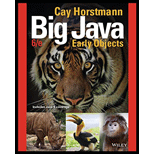
Big Java, Binder Ready Version: Early Objects
6th Edition
ISBN: 9781119056447
Author: Cay S. Horstmann
Publisher: WILEY
expand_more
expand_more
format_list_bulleted
Question
Chapter 12.1, Problem 3SC
Program Plan Intro
CRC card method:
- The CRC method is used to find the responsibilities of a class.
- The CRC stands for “Classes”, “Responsibilities”, “Collaborators”.
- The CRC cards describes a class, responsibility of that class and its collaborating classes.
- The CRC method creates an index card for each classes.
- It picks the class that is responsible for every method.
- It writes the class’s responsibilities.
- It indicated the name of the classes needed to full fill the responsibilities. These extra classes are called as the collaborators.
Expert Solution & Answer
Want to see the full answer?
Check out a sample textbook solution
Students have asked these similar questions
I need to define and discuss the uses of one monitoring or troubleshooting tool in Windows Server 2019. thank you
Why is planning for the retirement system and transition critical?
Please answer the question correctly please. Thank you!!
Chapter 12 Solutions
Big Java, Binder Ready Version: Early Objects
Ch. 12.1 -
What is the rule of thumb for finding classes?
Ch. 12.1 -
Your job is to write a program that plays chess....Ch. 12.1 - Suppose the invoice is to be saved to a file. Name...Ch. 12.1 - Looking at the invoice in Figure 1, what is a...Ch. 12.1 - Prob. 5SCCh. 12.2 - Consider the CashRegisterTester class of Section...Ch. 12.2 - Prob. 7SCCh. 12.2 - Consider the Quiz class described in Section...Ch. 12.2 - Why should coupling be minimized between...Ch. 12.2 - Prob. 10SC
Ch. 12.2 - You are implementing a system to manage a library,...Ch. 12.2 - Prob. 12SCCh. 12.3 - Which class is responsible for computing the...Ch. 12.3 - Prob. 14SCCh. 12 - Prob. 1RECh. 12 - Give a rule of thumb for how to find classes when...Ch. 12 - Give a rule of thumb for how to find methods when...Ch. 12 - Prob. 4RECh. 12 - Prob. 5RECh. 12 - Prob. 6RECh. 12 - Prob. 7RECh. 12 - Prob. 8RECh. 12 - Prob. 9RECh. 12 - Prob. 10RECh. 12 - Prob. 11RECh. 12 - Prob. 12RECh. 12 - Prob. 13RECh. 12 - Prob. 14RECh. 12 - Prob. 15RECh. 12 - Prob. 1PECh. 12 - Prob. 2PECh. 12 - Prob. 3PECh. 12 - Prob. 4PECh. 12 - Prob. 5PECh. 12 - Prob. 6PECh. 12 - Prob. 1PPCh. 12 - Prob. 2PPCh. 12 - Prob. 3PPCh. 12 - Prob. 4PPCh. 12 - Prob. 5PPCh. 12 - Prob. 6PPCh. 12 - Prob. 7PPCh. 12 - Prob. 8PPCh. 12 - Prob. 9PPCh. 12 - Prob. 10PP
Knowledge Booster
Learn more about
Need a deep-dive on the concept behind this application? Look no further. Learn more about this topic, computer-science and related others by exploring similar questions and additional content below.Similar questions
- Please answer the question correctly please. Thank you!!arrow_forwardPlease solve and answer the questions correctly please. Thank you!!arrow_forwardConsidering the TM example of binary sum ( see attached)do the step-by-step of execution for the binary numbers 1101 and 11. Feel free to use the Formal Language Editor Tool to execute it; Write it down the current state of the tape (including the head position) and indicate the current state of the TM at each step.arrow_forward
- I need help on inculding additonal code where I can can do the opposite code of MatLab, where the function of t that I enter becomes the result of F(t), in other words, turning the time-domain f(t) into the frequency-domain function F(s):arrow_forwardI need help with the TM computation step-by-step execution for the binary numbers 1101 and 11. Formal Language Editor Tool can be used to execute it; Write it down the current state of the tape (including the head position) and indicate the current state of the TM at each step;arrow_forwardWriting an introduction manual for software designarrow_forward
arrow_back_ios
SEE MORE QUESTIONS
arrow_forward_ios
Recommended textbooks for you
 Database System ConceptsComputer ScienceISBN:9780078022159Author:Abraham Silberschatz Professor, Henry F. Korth, S. SudarshanPublisher:McGraw-Hill Education
Database System ConceptsComputer ScienceISBN:9780078022159Author:Abraham Silberschatz Professor, Henry F. Korth, S. SudarshanPublisher:McGraw-Hill Education Starting Out with Python (4th Edition)Computer ScienceISBN:9780134444321Author:Tony GaddisPublisher:PEARSON
Starting Out with Python (4th Edition)Computer ScienceISBN:9780134444321Author:Tony GaddisPublisher:PEARSON Digital Fundamentals (11th Edition)Computer ScienceISBN:9780132737968Author:Thomas L. FloydPublisher:PEARSON
Digital Fundamentals (11th Edition)Computer ScienceISBN:9780132737968Author:Thomas L. FloydPublisher:PEARSON C How to Program (8th Edition)Computer ScienceISBN:9780133976892Author:Paul J. Deitel, Harvey DeitelPublisher:PEARSON
C How to Program (8th Edition)Computer ScienceISBN:9780133976892Author:Paul J. Deitel, Harvey DeitelPublisher:PEARSON Database Systems: Design, Implementation, & Manag...Computer ScienceISBN:9781337627900Author:Carlos Coronel, Steven MorrisPublisher:Cengage Learning
Database Systems: Design, Implementation, & Manag...Computer ScienceISBN:9781337627900Author:Carlos Coronel, Steven MorrisPublisher:Cengage Learning Programmable Logic ControllersComputer ScienceISBN:9780073373843Author:Frank D. PetruzellaPublisher:McGraw-Hill Education
Programmable Logic ControllersComputer ScienceISBN:9780073373843Author:Frank D. PetruzellaPublisher:McGraw-Hill Education

Database System Concepts
Computer Science
ISBN:9780078022159
Author:Abraham Silberschatz Professor, Henry F. Korth, S. Sudarshan
Publisher:McGraw-Hill Education

Starting Out with Python (4th Edition)
Computer Science
ISBN:9780134444321
Author:Tony Gaddis
Publisher:PEARSON

Digital Fundamentals (11th Edition)
Computer Science
ISBN:9780132737968
Author:Thomas L. Floyd
Publisher:PEARSON

C How to Program (8th Edition)
Computer Science
ISBN:9780133976892
Author:Paul J. Deitel, Harvey Deitel
Publisher:PEARSON

Database Systems: Design, Implementation, & Manag...
Computer Science
ISBN:9781337627900
Author:Carlos Coronel, Steven Morris
Publisher:Cengage Learning

Programmable Logic Controllers
Computer Science
ISBN:9780073373843
Author:Frank D. Petruzella
Publisher:McGraw-Hill Education
Files & File Systems: Crash Course Computer Science #20; Author: CrashCourse;https://www.youtube.com/watch?v=KN8YgJnShPM;License: Standard YouTube License, CC-BY
UNIX Programming (Part - 10) The File System (Directories and Files Names); Author: ITUTEES;https://www.youtube.com/watch?v=K35faWBhzrw;License: Standard Youtube License